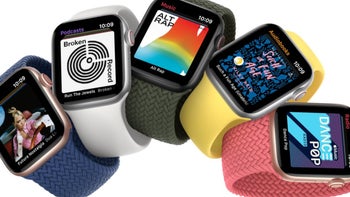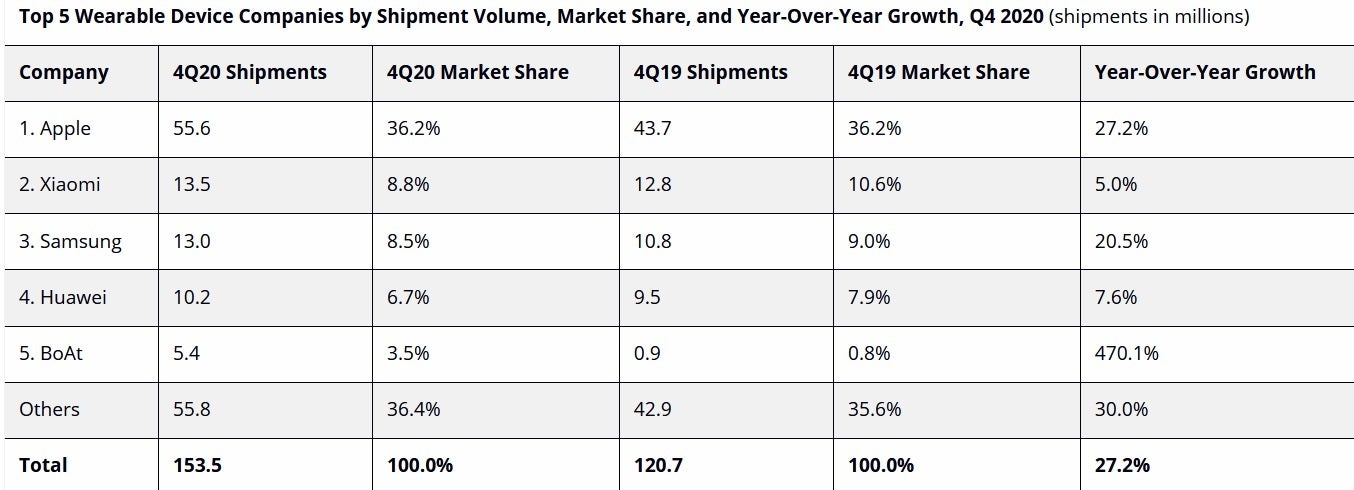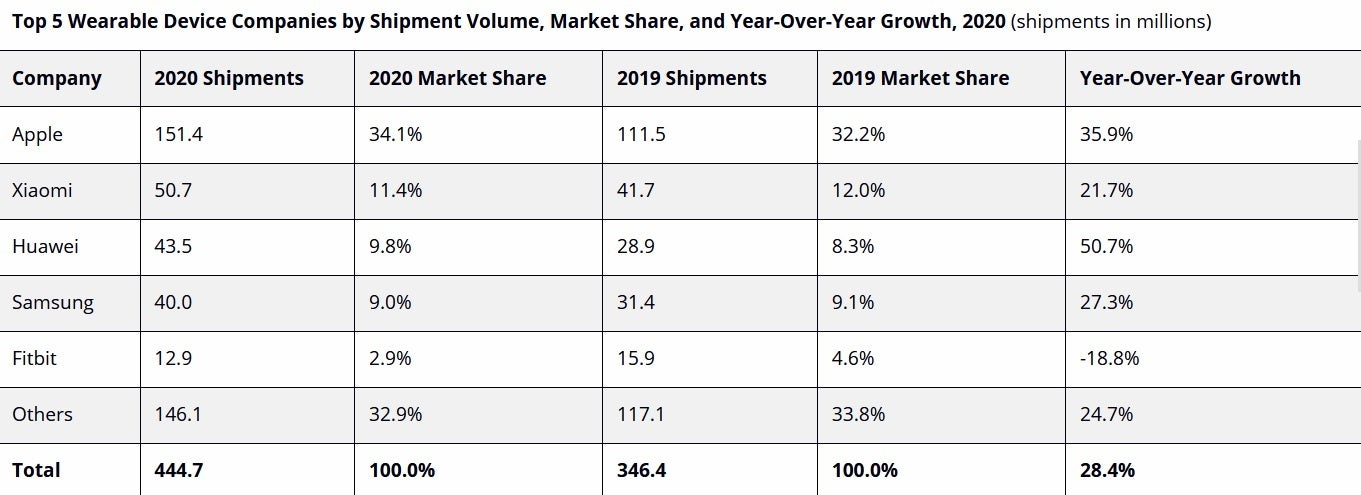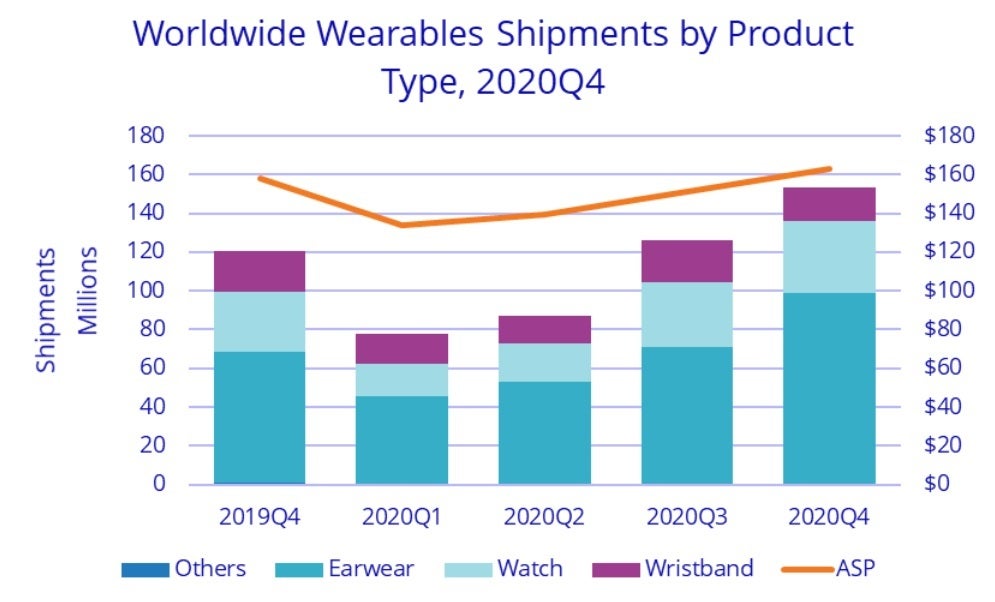Apple-Xiaomi are numbers one and two worldwide in the wearables market

According to IDC, Apple continues to be the dominant name in the wearables market. Led by a pair of top selling products, the Apple Watch and the AirPods, the firm delivered 55.6 million devices during the fourth quarter for a 36.2% slice of the wearable pie. That was a 27.2% increase in shipments year-over-year. To show you how competitive and rapidly growing the wearables market is, despite that gain in shipments year over year, Apple's 36.2% market share was exactly the same as it was during the same quarter in 2019. Apple found support by shipping 45.6% more Apple Watches on a year-over-year basis thanks to three different price points that Apple has for its timepiece (Apple Watch series 6, Apple Watch SE, and Apple Watch Series 3).
Apple is the leading shipper of wearables like ear buds and smartwatches worldwide
Despite a Q4 decline of 18.3% in shipments of the popular and low cost Xiaomi Mi Band fitness tracker, Xiaomi reported Q4 growth in wearable shipments of 5% thanks to its "hearables" line which delivered 55.5% more product on an annual basis. Xiaomi shipped 13.5 million wearable units during the three month period from October through December for a market share of 8.8%. That put the "value for money" manufacturer in second place far behind Apple, but just slightly above Samsung. The latter shipped 13 million wearables during Q4 2020; while that was a 20.5% increase in shipments year-over-year, over the same period of time the company saw its market share decline from 9% to 8.5%.

Apple delivered the most wearable devices globally during the fourth quarter of 2020
Huawei reported a 7.6% year-over-year gain in wearable shipments during the fourth quarter which means that it delivered 10.2 million units during the three month period. The manufacturer's market share declined to 6.7% from 7.9% the year before. Indian wearable company BoAt finished fifth after shipping 5.4 million units for a 3.5% share of the wearables market. The company saw the number of wearable devices it shipped soar 470.1% from Q4 2019 to Q4 2020. Overall, 153.5 million wearable devices were shipped during the fourth quarter of 2020, up 27.2% from the 120.7 million wearables that were delivered during the same quarter last year.

Apple also led all manufacturers in shipping wearables worldwide during 2020
For all of 2020, IDC has Apple shipping 151.4 million units for a 35.9% share of the wearables market. That is up 34.1% from the number of wearables that the company shipped in 2019. Xiaomi and Huawei were second and third shipping 50.7 million and 43.5 million units respectively. Xiaomi had 11.4% of the global wearable market after a 21.7% gain in deliveries last year. Huawei had a strong 50.7% increase in the shipments of wearables in 2020 allowing its market share to increase from 8.3% to 9.8%. Samsung shipped 40 million wearable devices last year placing it fourth with a flat 9% slice of the wearable pie. Fitbit is owned by Google parent Alphabet and shipped 12.9 million units in 2020. That was an 18.8% decline year-over-year.

Earwear was the most delivered wearable device during the fourth quarter of 2020
For all of 2020, 444.7 million wearables were delivered worldwide, 28.4% ahead of the 346.4 million that were shipped in 2019. The leading wearable device shipped during Q4 was the in-ear wearable with nearly $100 million in revenue. That was up 43% from the $70 million of in-ear devices that shipped during the same quarter last year. Approximately $40 million in smartwatches were delivered last quarter along with $12-13 million in wristband sales. The average wearable was priced at a little over $160 during the fourth quarter last year, a slight increase on a year-over-year basis.
Apple hopes to hold on to its leading position in the wearables market by releasing a third-generation AirPods and an AirPods Pro sequel later this year. And this September, the Apple Watch Series 7 is rumored to be unveiled carrying a blood glucose meter that will save millions of insulin dependent diabetics the expense and pain of testing themselves multiple times per day to determine how much insulin they need to inject. Samsung also is rumored to offer the same feature for its next smartwatch.













Things that are NOT allowed: